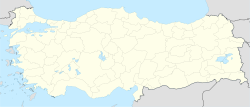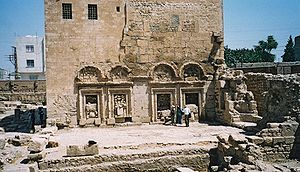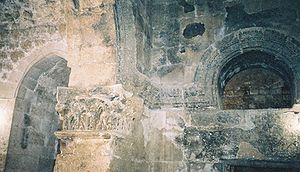- Nusaybin
-
Nusaybin — District — Location of Gelibolu Coordinates: 37°04′N 41°13′E / 37.067°N 41.217°E Country  Turkey
TurkeyRegion Southeastern Anatolia Province Mardin Province Government – Mayor Ayşe Gökkan (BDP) – Governor Yücel Gemici Area – District 825 km2 (318.5 sq mi) Elevation 0 m (0 ft) Population (2010) – District 44,697 – Density 54/km2 (139.9/sq mi) – Urban 22,832 Time zone EET (UTC+2) – Summer (DST) EEST (UTC+3) Postal code 47300 Area code(s) 482 Licence plate 47 Website www.nusaybin.bel.tr Nusaybin (pronounced [nuˈsajbin]; Akkadian: Naṣibina;[1] classical Nisibis; Syriac: ܢܨܝܒܝܢ, Niṣībīn; Armenian: Մծբին, Mtsbin; Kurdish: Nisêbîn) is a city in Mardin Province, Turkey, populated mainly by Kurds. Earlier Arameans, Arabs, and Armenians lived in the city. The population of the city is 83,832[2] as of 2009.
Contents
History
Ancient Period
First mentioned in 901 BC, Naşibīna was an Aramaean kingdom captured by the Assyrian king Adad-Nirari II in 896.[3] By 852 BC, Naṣibina had been fully annexed to the Neo Assyrian Empire and appeared in the Assyrian Eponym List as the seat of an Assyrian provincial governor named Shamash-Abua.[4] It remained part of the Assyrian Empire until its collapse in 608 BC, and Assyrians still remain in the city to this day.[citation needed]
It was under Babylonian control until 536 BC, when it fell to the Achamaenid Persians, and remained so until taken by Alexander the Great in 332 BC. The Seleucids refounded the city as Antiochia Mygdonia (Greek: Αντιόχεια της Μυγδονίας), mentioned for the first time in Polybius' description of the march of Antiochus III the Great against the Molon (Polybius, V, 51). Greek historian Plutarch suggested that the city was populated by Spartan descendants. Around the 1st century AD, Nisibis (נציבין, Netzivin) was the home of Judah ben Bethera, who founded a famous yeshiva there.[5]
Classical Period
Like many other cities in the marches where Roman and Parthian powers confronted one another, Nisibis was often taken and retaken: it was captured by Lucullus after a long siege from the brother of Tigranes (Dion Cassius, xxxv, 6, 7); and captured again by Trajan in 115, for which he gained the name of Parthicus (ibid., LXVIII, 23), then lost and regained against the Jews during the Kitos War. Lost in 194, it was again conquered by Septimius Severus, who made it his headquarters and re-established a colony there (ibid., LXXV, 23). With the fresh energy of the new Sassanid dynasty, Shapur I conquered Nisibis, was driven out, and returned in the 260s. In 298, by a treaty with Narseh, the province of Nisibis was acquired by the Roman Empire.
The Roman historian of the 4th century Ammianus Marcellinus gained his first practical experience of warfare as a young man at Nisibis under the master of the cavalry, Ursicinus. From 360 to 363, Nisibis was the camp of Legio I Parthica. Because of its strategic importance on the Persian border Nisibis was heavily fortified. Ammianus lovingly calls Nisibis the "impregnable city" (urbs inexpugnabilis) and "bulwark of the provinces" (murus provinciarum).
Nisbis was a Persian city with mainly Persian population. Some 12,000 Persians of good lineage from Istakhr, Isfahan, and other regions settled at Nisibis in the 4th century[6], and their descendents were still there at the beginning of the 7th century.[7]
In 363 Nisibis was ceded back to the Persians after the defeat of Julian. Before that time the population of the town was forced by the Roman authorities to leave Nisibis and move to Amida. Emperor Jovian allowed them only three days for the evacuation. Historian Ammianus Marcellinus was again an eyewitness and condemns Emperor Jovian for giving up the fortified town without a fight. Marcellinus' point-of-view is certainly in line with contemporary Roman public opinion.
Nisibis (Syriac: ܢܨܝܒܝܢ, Nṣibin, later Syriac ܨܘܒܐ, Ṣōbā) had an Assyrian Christian bishop from 300, founded by Babu (died 309). War was begun again by Shapur II in 337, who besieged the city in 338, 346 and 350, when Jacob (James) of Nisibis, Babu's successor, was its bishop. Nisibis was the home of Ephrem the Syrian, who remained until its surrender to the Persians by Jovian in 363.
Later, the bishop of Nisibis was the ecclesiastic metropolitan of the Province of Bit-Arbaye. In 410 it had six suffragan sees and as early as the middle of the 5th century was the most important episcopal see of the Church of the East after Seleucia-Ctesiphon, and many of its Nestorian, Assyrian Church of the East or Jacobite bishops were renowned for their writings: Barsumas, Osee, Narses, Jesusyab, Ebed-Jesus.
The first theological, philosophical, and medical School of Nisibis, founded at the introduction of Christianity into the city by ethnic Assyrians of the Assyrian Church of the East,[8] was closed when the province was ceded to the Persians. Ephrem the Syrian, an Assyrian poet, commentator, preacher and defender of orthodoxy, joined the general exodus of Christians and reestablished the school on more securely Roman soil at Edessa. In the 5th century the school became a center of Nestorian Christianity, and was closed down by Archbishop Cyrus in 489; the expelled masters and pupils withdrew once more to Nisibis, under the care of Barsumas, who had been trained at Edessa, under the patronage of Narses, who established the statutes of the new school. Those that have been discovered and published belong to Osee, the successor of Barsumas in the See of Nisibis, and bear the date 496; they must be substantially the same as those of 489. In 590 they were again modified. The monastery school was under a superior called Rabban ("master"), a title also given to the instructors. The administration was confided to a majordomo, who was steward, prefect of discipline, and librarian, but under the supervision of a council. Unlike the Jacobite schools, devoted chiefly to profane studies, the school of Nisibis was above all a school of theology. The two chief masters were the instructors in reading and in the interpretation of Holy Scripture, explained chiefly with the aid of Theodore of Mopsuestia. The free course of studies lasted three years, the students providing for their own support. During their sojourn at the university, masters and students led a monastic life under somewhat special conditions. The school had a tribunal and enjoyed the right of acquiring all sorts of property. Its rich library possessed a most beautiful collection of Nestorian works; from its remains Ebed-Jesus, Bishop of Nisibis in the 14th century, composed his celebrated catalogue of ecclesiastical writers. The disorders and dissensions, which arose in the sixth century in the school of Nisibis, favoured the development of its rivals, especially that of Seleucia; however, it did not really begin to decline until after the foundation of the School of Baghdad (832). Among its literary celebrities mention should be made of its founder Narses; Abraham, his nephew and successor; Abraham of Kashgar, the restorer of monastic life; John; Babai the Elder.
Modern history
Modern Nusaybin remains the site of two titular sees in the Chaldean Catholic Church, Nisibenus Chaldaeorum, and Nisibenus; the first seat is held by Jacques Ishaq, titular Archbishop, the second has been vacant since 1968.[9][10]
Mass graves
Nusaybın made headlines in 2006 when villagers near Kuru uncovered a mass grave, suspected of belonging to Ottoman Armenians and Assyrians.[11] Swedish historian David Gaunt visited the site to investigate its origins, but left after finding evidence of tampering.[12][13] Gaunt, who has studied 150 massacres carried out in the summer of 1915 in Mardin, said that the Committee of Union and Progress's governor for Mardin, Halil Edip, had likely ordered the massacre on 14 June 1915, leaving 150 ethnic Armenians and 120 ethnic Assyrians dead. The settlement was then known as Dara (now Oğuz). Gaunt added that the death squad, named El-Hamşin (meaning "fifty men"), was headed by officer Refik Nizamettin Kaddur. The president of the Turkish Historical Society, Yusuf Halaçoğlu, said that the remains dated back to Roman times.[14]
Özgür Gündem says that the military and police have pressed the media not to report the discovery.[15]
Geography
Nusaybin is immediately north of the border with Syria, opposite the Syrian city of Al-Qamishli. The Jaghjagh River flows through both cities.
Climate
Nusaybin has a semi-arid climate with extremely hot summers and cool winters. Rainfall is generally sparse.
Climate data for Nusaybin Month Jan Feb Mar Apr May Jun Jul Aug Sep Oct Nov Dec Year Average high °C (°F) 11
(52)13
(55)17
(63)22
(72)30
(86)37
(99)41
(106)40
(104)35
(95)28
(82)20
(68)13
(55)25.6
(78.0)Average low °C (°F) 3
(37)4
(39)7
(45)11
(52)16
(61)21
(70)25
(77)24
(75)20
(68)16
(61)9
(48)5
(41)13.4
(56.2)Precipitation mm (inches) 51
(2.01)30
(1.18)35
(1.38)26
(1.02)16
(0.63)0
(0)0
(0)0
(0)0
(0)12
(0.47)19
(0.75)34
(1.34)223
(8.78)Avg. rainy days 8 7 7 5 2 0 0 0 0 2 4 6 41 Source: Weather2 [16] Transportation
Nusaybin is served by the E90 roadway and other roads to surrounding towns. The Nusaybin Railway Station is served by 2 trains per day. The closest airport is the Kamishly Airport 5 kilometers south from Nusaybin, located in Al Qamishli in Syria. The closest Turkish airport is the Mardin Airport, 55 kilometers northwest of Nusaybin.
See also
- Mt. Izla
- Nisibis (East Syrian Ecclesiastical Province)
- Febronia of Nisibis
References
- ^ Mechanisms of Communication in the Assyrian Empire. "People, gods, & places." History Department, University College London, 2009. Accessed 18 Dec 2010.
- ^ http://tuikapp.tuik.gov.tr/adnksdagitapp/adnks.zul
- ^ Lendering, Jona. "Nisibis." Accessed 18 Dec 2010.
- ^ Lendering, Jona. Assyrian Eponym List. Accessed 18 Dec 2010.
- ^ Talmud, Sanhedrin 32b
- ^ Ṭabari, I, p. 843; tr., V, pp. 62-63; Dinavari, p. 50: See: Iranica: IRAQ i. IN THE LATE SASANID AND EARLY ISLAMIC ERAS.
- ^ Iranica: IRAQ i. IN THE LATE SASANID AND EARLY ISLAMIC ERAS
- ^ Jonsson, David J. (2005). The Clash of Ideologies. Xulon Press. p. 181. ISBN 1-59781-039-8. http://books.google.com/books?id=pXstU5Kt-_kC&pg=PA182&dq=school+of+nisibis+assyrian#PPA181,M1.
- ^ David M. Cheney. "Nisibis dei Caldei (Titular See)". Catholic-hierarchy.org. http://www.catholic-hierarchy.org/diocese/d2n58.html. Retrieved 2008-09-22.
- ^ David M. Cheney. "Nisibis (Titular See)". Catholic-hierarchy.org. http://www.catholic-hierarchy.org/diocese/d2n57.html. Retrieved 2008-09-22.
- ^ Oruc, Berguzar (2006-10-19). These were victims of the Armenian Genocide and Assyrian Genocide, victims of Ottoman massacres during World War 1. "Ermeni köyu'nde toplu mezar" (in Turkish). Dicle Haber (Özgür Gündem). http://www.gundemonline.org/haber.asp?haberid=21953 These were victims of the Armenian Genocide and Assyrian Genocide, victims of Ottoman massacres during World War 1.. Retrieved 2008-09-23.
- ^ Gunaysu, Ayse (2006-11-07). "Toplu mezar Ermeni ve Süryanilere ait" (in Turkish). Özgür Gündem. http://gundemonline.org/haber.asp?haberid=23426. Retrieved 2008-09-23.
- ^ Belli, Onur Burcak (2007-04-27). "Truth of mass grave eludes Swedish professor". Turkish Daily News. http://historyandreconciliation.org/blog/?itemid=60. Retrieved 2008-09-23.
- ^ "Toplu mezarla yüzleşme vakti" (in Turkish). Özgür Gündem. 2006-12-13. http://www.gundemonline.org/haber.asp?haberid=25931. Retrieved 2008-09-23.
- ^ Oruc, Berguzar (2006-10-22). "Toplu mezar gizleniyor". Dicle Haber (Özgür Gündem). http://www.gundemonline.org/haber.asp?haberid=22211. Retrieved 2008-09-23.
- ^ http://www.myweather2.com/City-Town/Turkey/Nusaybin/climate-profile.aspx
External links
- Nisibis, Catholic Encyclopedia
- [1], Hürriyet Daily News and Economic Review
 Nusaybin in Mardin Province (in the Southeastern Anatolia region) of Turkey
Nusaybin in Mardin Province (in the Southeastern Anatolia region) of TurkeyUrban districts 
Rural districts RegionsAegean Black Sea Central Anatolia Eastern Anatolia Marmara Mediterranean Southeastern Anatolia Categories:- Districts of Mardin
- Southeastern Anatolia Region
- Archaeological sites in Turkey
- Ancient Greek sites in Turkey
- Syriac Christianity
- Hellenistic colonies
- Roman sites in Turkey
- Roman legions' camps in Turkey
- Titular sees
- Towns in Turkey
- Assyrian settlements
- Populated places in Mardin Province
- Syria–Turkey border crossings
Wikimedia Foundation. 2010.





